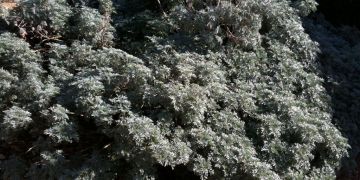Medicinal Uses of Wormwood
Sources from the Ancient World and the Middle Ages indicate that many varieties were useful for insecticides, to be strewn among floor rushes or dried and packed among furs and textiles to prevent moth and flea infestations. It also places prominently in love potions and philters of the Middle Ages. While it may truly be useful for repelling insects, more fascinating is the place it rightfully holds in modern pharmacopeias.
Digestive aid
The bitter components and acids render wormwood an excellent remedy for digestive issues. This is primarily because a bitter flavor on the tongue actually causes the gallbladder to produce and release bile. Contrary to popular belief, it is often too little acid production that leads to most indigestion, not an excess of it. It is also noted as being useful in alleviating fever, expelling parasitic worms like roundworm from the digestive tract, and for its tonic effects. It may also be applied topically to reduce inflammation of insect bites and promote healing. Wormwood is also noted to be useful in treating jaundice, a sign of liver dysfunction and to increase sexual desire.
Habitat & Appearance of Wormwood
Species in this genus grow to approximately two feet in height. Their leaves have an almost feathery appearance and both the stem and upper surface of the leaves are covered with small, whitish hairs. Artemisia species can be found in much of the northern and western parts of Europe, where they grow wild in waste spaces. It is thought that several of these species were once commonly cultivated for their medicinal and insect repelling properties. Several may also be found throughout the North American continent as naturalized species, and in the steppes of Northern Asia. Many varieties of wormwood favor shady areas and can often be found as scrub vegetation in the understory level of more developed tracts vegetation. However, several species favor more arid and open conditions than those typically found in woodland habitats.
Active Ingredients in Wormwood
Wormwood possesses a volatile oil, which, when the plant essence is distilled, exhibits approximately .5%-1% of the resultant liquid. It is often blue or green in color and gives off a strong, bitter smell. The oil itself is a cocktail of thujone (absinthe or tenaceton), thujanol alcohol (both free and combined with acetic iso valerianic, succinic, and malic acids), cadinene, phellandrene, and pinene. The herb also contains quantities of tannin, resin, nitrate of potash, other salts, the bitter glucoside absinthe, and absinthic acid. Often, the entire herb—root, stem and leaves, and flowers—is used in various preparations.
Properly collected and dried leaves and flowers of wormwood, collected on a warm, sunny day after blooming has begun in July and dried in partial sun not cooler than 70 degrees Fahrenheit, may be steeped as a tea in the following proportions: one ounce of dried leaves steeped for 10-12 minutes in one pint of boiling water. The essential oils are also useful for dispelling intestinal worms. Caution should be taken with wormwood however, as taking too much can cause diarrhea because it stimulates swift emptying of the intestines as a part of its tonic effects.





